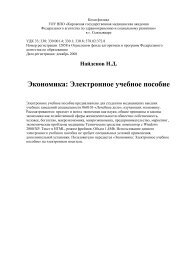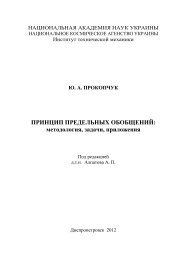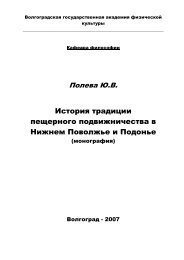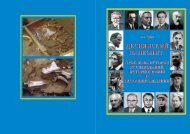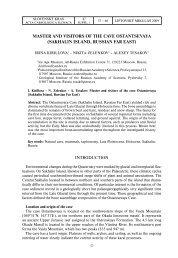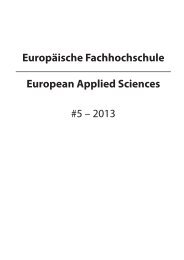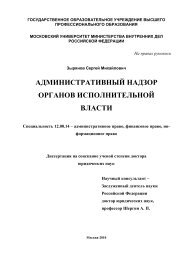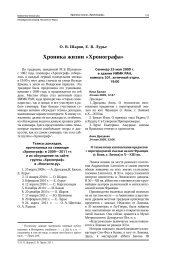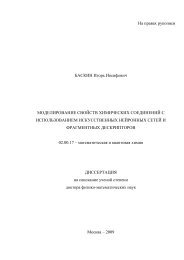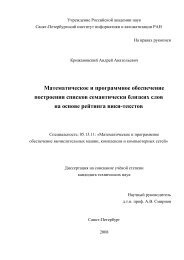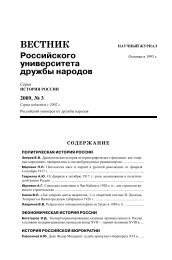Influence of Coulomb scattering of electrons and holes between ...
Influence of Coulomb scattering of electrons and holes between ...
Influence of Coulomb scattering of electrons and holes between ...
Create successful ePaper yourself
Turn your PDF publications into a flip-book with our unique Google optimized e-Paper software.
ARTICLE IN PRESSS.A. Moskalenko et al. / Physica E 39 (2007) 137–149 141where V s;k is the 2D Fourier transform <strong>of</strong> the <strong>Coulomb</strong>interaction2pe 2V s;k ¼ p 0 Sffiffiffiffiffiffiffiffiffiffiffiffiffiffi . (9)s 2 þ k 2The application <strong>of</strong> these matrix elements for derivation <strong>of</strong>the lowest exciton b<strong>and</strong>s will be shown in Section 4. Themain subject <strong>of</strong> the present paper concerns the simultaneousquantum transitions <strong>of</strong> two quasiparticles due totheir <strong>Coulomb</strong> <strong>scattering</strong>.Quantum transitions associated with <strong>Coulomb</strong> interactionsare allowed without changing the spins <strong>of</strong> interactingparticles. Since we are concerned only in the LLLs, whichcan accommodate all particles at zero temperature <strong>and</strong>high magnetic field, we consider virtual transitions, where aparticle is first promoted from the LLL to the ELL, <strong>and</strong>then reverted to the LLL. We restrict ourselves with thesimultaneous virtual transitions <strong>of</strong> two particles, butallowing them to be excited in LLs with arbitrary n <strong>and</strong>m. Such virtual transitions correspond to matrix elementsF i2j ðp; 0; q; 0; p s; n; q þ s; mÞ <strong>and</strong> F i2j ðp; n; q; m; ps; 0; q þ s; 0Þ with i; j ¼ e; h. As a result, these transitionswill induce indirect interaction <strong>between</strong> particles in theLLLs <strong>and</strong> influence essentially on the BEC <strong>of</strong> magnetoexcitons.Such indirect interaction is attractive <strong>and</strong> appears inthe second order <strong>of</strong> the perturbation theory. Following thestatements <strong>of</strong> the paper [26], the main role is played by thesimultaneous quantum transitions with n 0 ¼ m 0 ¼ n. However,the quantum transitions with nam have to be alsotaken into account <strong>and</strong> we will show that the virtualquantum transitions with participation <strong>of</strong> the e–h pair giverise to the contributions <strong>of</strong> two types, which are bothdepended on the magnetoexciton wave vector k, butexhibitingvanishing or non-vanishing behavior at the pointk ¼ 0. The indirect e–e <strong>and</strong> h–h interaction lead tocontributions, which do not depend on k. It was shown[28] that for n ¼ m ¼ 1 this indirect interaction gives rise tothe shift <strong>of</strong> the magnetoexciton levels <strong>and</strong> influence onBEC. The aim <strong>of</strong> this section is to generalize the resultsobtained in Ref. [28] <strong>and</strong> to determine the influence <strong>of</strong> allELLs with arbitrary n <strong>and</strong> m.We start with rewriting the Hamiltonian Eq. (2) byseparating the term H LLLCoul , which contains only the LLLs<strong>and</strong> the term H ELLCoul , which describes the simultaneoustransitions ð0; 0Þ$ðn; mÞ discussed above, while all othersterms entering Eq. (2) will be neglected:H ¼ H 0 þ H LLLCoul þ HELL Coul . (10)From now on particle operators with n ¼ m ¼ 0willbedenoted as a y p ; a p; b y p <strong>and</strong> b p . The term H ELLCoul can beexcluded from the Hamiltonian Eq. (10) with the aid <strong>of</strong>unitary transformation [32,33] ^U ¼ exp½i ^SŠ, where ^S ¼ ^S yis determined from the equationELLi½ ^H 0 ; ^SŠþHCoul ¼ 0. (11)Averaging the transformed Hamiltonian on the groundstate <strong>of</strong> <strong>electrons</strong> <strong>and</strong> <strong>holes</strong> in ELLs j0i ELL we obtain aneffective HamiltonianH eff ¼ ELL h0je iS ^He iS j0iXELL’ m e a y p a Xp m h b y p b p þ H LLLCoulpþ i 2 ELLh0j½HELL Coul ; ^SŠj0i ELL,which can be written asXH eff ¼ m e a y p a Xp m h b y p b p þ H LLLCoulpppð12Þ1 Xf2 e2e ðp; q; zÞa y p ay q a qþza p zp;q;z1 Xf2 h2h ðp; q; zÞb y p by q b qþzb p zp;q;zXf e2h ðp; q; zÞa y p by q b qþza p z . ð13Þp;q;zHere the indirect interaction matrix elements f i j ðp; q; zÞare given by the expressionsf i2j ðp; q; zÞ ¼ X f i2j ðp; q; z; n; mÞ,n_on;m ci þ m_o cjf i2j ðp; q; z; n; mÞ ¼ X F i2j ðp; 0; q; 0; p t; n; q þ t; mÞtF i2j ðp t; n; q þ t; m; p z; 0;q þ z; 0Þ.ð14ÞMaking use <strong>of</strong> the definition Eq. (5) <strong>and</strong> notations <strong>of</strong> Eq.(8) one can write <strong>Coulomb</strong> matrix elements in the followingform:F i2i ðp; n; q; m; p s; 0; q þ s; 0Þ¼ ffiffiffiffiffiffiffiffiffiffiffiffiffiffiffiffiffiffið 1Þm XpW2 nþm s;k f ðk; p q sÞð s þ ikÞ nþm l nþm ,n!m! kF i2i ðp; 0; q; 0; p s; n; q þ s; mÞ¼ ffiffiffiffiffiffiffiffiffiffiffiffiffiffiffiffiffiffið 1Þm XpW2 nþm s;k f ðk; p q sÞðs þ ikÞ nþm l nþm ,n!m! kF e2h ðp; 0; q; 0; p t; n; q þ t; mÞ1 X¼ pffiffiffiffiffiffiffiffiffiffiffiffiffiffiffiffiffiffiW2 nþm t;k f ðk; p þ qÞ½t þ ikŠ n ½t ikŠ m l nþm ,n!m! kF e2h ðp t; n; q þ t; m; p z; 0; q þ z; 0Þ1 X¼ pffiffiffiffiffiffiffiffiffiffiffiffiffiffiffiffiffiffiW2 nþm t z;s f ðs; p þ qÞ½ðt zÞþisŠ nn!m! s½ðt zÞ isŠ m l nþm . ð15ÞAfter straightforward calculation the indirect interactionmatrix elements take the following form:f i2i ðp; q; z; n; mÞ ¼l2ðnþmÞ X2 nþm W t;k W z t;s f ðk; p q tÞn!m!t;k;sf ðk; p q t zÞðt þ ikÞ nþmðt z þ isÞ nþm ,



